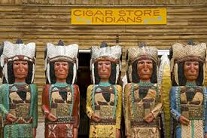Indian statues make up a uniquely American art form that parallels the rise of tobacco as America’s first big cash crop. The typical cigar store Indian statue on the sidewalk had its heyday in the second half of the 19th century, and stood as a sig
In today’s America, many people’s only knowledge of Indian statues comes from an episode of the 90s sitcom “Seinfeld” in which a cigar store Indian statue is crucial to the plotline. But if you look a little deeper at the information available about cigar store Indian statues, the real story is complex and fascinating, telling its own story of 18th, 19th, and early 20th century America.
Tobacco was America’s first cash crop, and the very first cigar store Indian statues were placed in tobacconist shops in England and labeled as “Virginie Men.” These were small wooden statues displayed on countertops. Since most people had never seen an actual American Indian, carvers made some rather creative guesses as to what they looked like when making these statues. The Virginie Men often had European features, black skin, headdresses, and tobacco leaf kilts.
The Indian statues in America were perhaps a little more realistic, but definitely played up the stereotypes of Native Americans as fringe and blanket-wearing figures holding spears or tomahawks. Because Native American tribes were as different from one another as Swedes are from Italians, the depictions would depend heavily on where the artist lived.
The purposes of cigar store Indian statues were two: to display intricate and elaborately carved wooden artwork, and to indicate to passers-by that tobacco was sold in the establishment that owned the statue. In the 19th century, America was bringing in immigrants from many European countries, many of whom could perhaps speak some English, but who couldn’t read it. For that matter, there were plenty of English-speaking European descendents born in America who couldn’t read. The Indian statue was a sure sign that tobacco could be acquired in a particular shop.
Statues varied widely, depicting Indian women with papooses, Indian princesses, braves, and chiefs, and often they held tobacco in their hands. The American wood carver who is believed to have made more Indian statues than anyone else, and whose work was most well known was a New York sculptor named Anderson Robb. He attended art school and spent over half a century carving Indian statues, from 1864 until 1924! Many of his statues were Indian women holding roses similar to roses he had sculpted for his wife’s tombstone after her death.
Today, it is nearly impossible to find a cigar store Indian statue with original paint. That is because the statues, which were often displayed on sidewalks outside tobacconist shops were frequently repainted to keep them fresh looking. The original polychrome paintwork done by the artist had a luminous, satiny finish, but this was often covered when the paint faded and the owner wanted his statue to look new. He would often hire an itinerant painter to take care of the task, and the paints used varied widely in composition and quality.
In the early 20th century, laws banning the obstruction of sidewalks caused many tobacconists to move their Indian statues indoors, but a fair number of them were sold off. Legend has it that many wooden cigar store Indian statues were used as firewood during the Great Depression of the 1930s, though it is difficult to find confirmation of this.
Though there are modern artists creating wooden Indian statues, the historic statues of the 1800s are rare enough to be quite valuable. A line-up of wooden cigar store Indian statues in chronological order from the 1600s to the early 20th century would tell its own unique version of the history of America.





